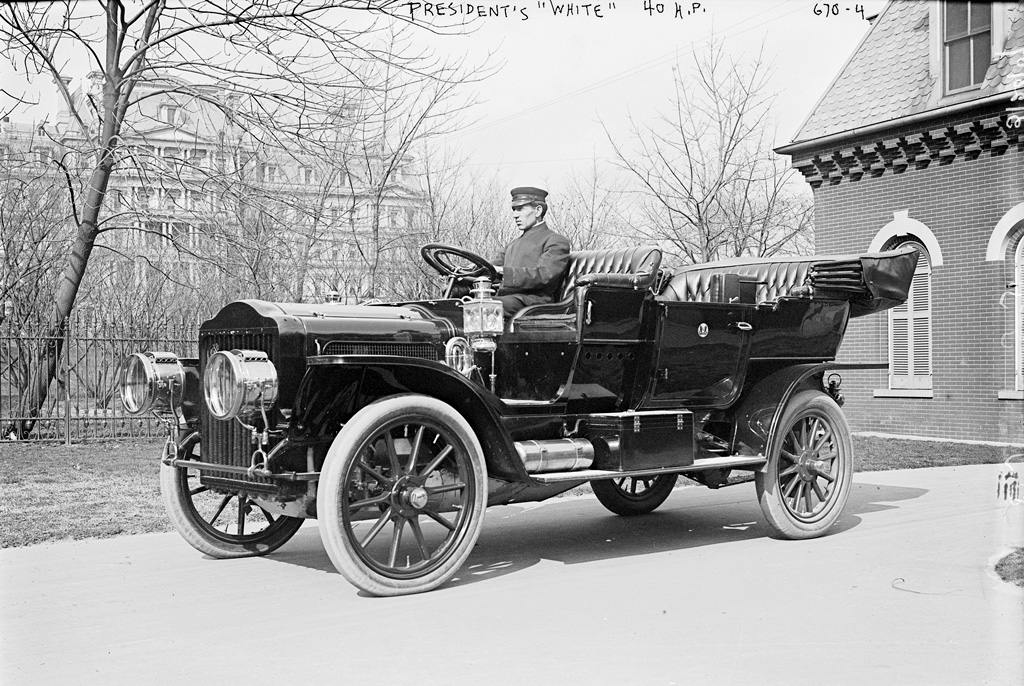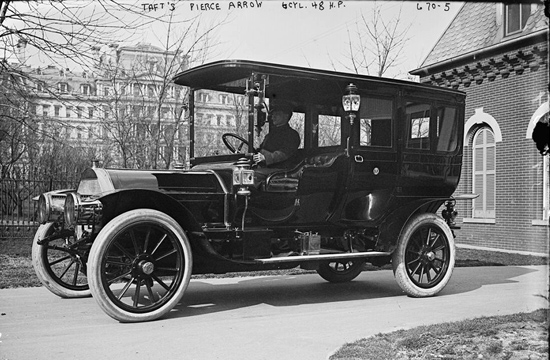
For more than 100 years after the founding of our country, the horse provided the most common means of transportation for the average citizen. Railroads were invented and expanded during that time, but the final miles for passengers and freight were covered by horses and wagons. However, near the end of the nineteenth century all that was about to change. And the change was promoted by one of our Presidents!
In 1899, William McKinley was the first president to ride in an automobile, a Locomobile steam carriage. During his presidency Theodore Roosevelt also rode in cars several times, but he preferred horses to automobiles and so had very little to do with them. It took the introduction of the Ford Model T in 1908 and the enormous interest in cars by the general public to finally bring the automobile to the White House as the preferred method of transportation. But when this happened, it happened in a big way.
In January of 1909, Congress passed legislation that officially provided $12,000 to purchase automobiles for use by the President. This didn’t go through without dissention, however. Democrat representative Thetus Sims of Tennessee argued that the automobile was “a dangerous means of travel, not only for the people who ride in it but for the pedestrians. The automobile is a genuine, all around nuisance. . . . I am opposed to this Congress going on record favoring automobiles as a means of travel.” Regardless of the protests against adopting the newfangled automobile for official use, the new transportation technology had a well-placed champion.
William Howard Taft had been elected the 27th President of the United States in 1908. It was a time of important new inventions and of the implementation of new technologies only recently invented. For example, the continuing construction of the electrical “grid” made cheap electric power available to industry and everyday people alike. With the grid came instant communication via telephone which piggybacked on the electrical infrastructure for its distribution. The continuing development of more reliable automobiles gave Americans the ability to travel as never before. President Taft saw the possibilities of the car and loved the freedom they would bring into their owners’ lives. He wanted to promote the fledgling auto industry. So Taft decided to buy some cars!
But which ones should he buy? Just as we do today, Taft thought about how the vehicles would be used and bought them according to those needs. It was a complicated decision because the cars of the time were remarkable in their variety. Pioneering auto makers did not yet have enough experience to know how to best design a car, and there was not even consensus on the best way to power them.
In 1908, steam engines were a well understood and accepted power source. Huge stationary and mobile engines powered factory machinery and railroad locomotives, but they could also be engineered into a compact form suitable for automobiles. Steam engines are extremely simple and very powerful, but require significant time at startup to develop operating pressure before driving away. Electric motors were seeing increased use in industry, and they could also be adapted to the automobile. They were very simple, clean, and were ready to go with the flip of a switch. However, the operating range of an electric car was limited by the primitive storage batteries of the day. Gasoline engines delivered good power and range, but they were complex and could be hard to start. Beautiful automobiles existed that used all three power types. So which one should Taft choose?
He bought all three types.
The honor of building the first automobile purchased by the White House for the use of the President went to The White Motor Company of Cleveland, Ohio. Taft selected a White Model M; a steam powered, 40 horsepower, seven-passenger touring car. It was used for formal occasions, and Taft rode to his 1909 inauguration in it. It became a favorite of the president because of its size and powerful performance. The White would exceed 60 miles per hour, and Taft regularly encouraged his chauffeur, George Robinson, to do just that! It was a huge vehicle well suited to Taft’s large stature, and it must have been a real challenge to maneuver it through Washington’s streets. It also must have been quite a sight with its great size, beautiful green finish decorated with the United States Coat of Arms, and filled with the President and other dignitaries!

Taft and his family in the White

Taft leaving the NYC Library
Not every occasion is an affair of state, however. To provide dignified transport for First Lady Helen Herron Taft and to use for pleasure trips as a couple, the President ordered a Pierce Arrow built in Buffalo, New York. Driven by chauffeur Abe Long, it was a 48 horsepower, six cylinder, gasoline engine-powered closed limousine of exquisite design and finish. Painted blue with rich russet doors and striping, it had the Great Seal of the United States applied to its doors. This Pierce Arrow was first used to transport President and Mrs. Taft to the opera.

The Pierce Arrows.

Mrs. Taft’s closed Pierce Arrow Limousine.
To complement these impressive machines, Taft also added a smaller Baker electric car to the fleet. The Baker was built in Cleveland, Ohio near the White automobile factory. It was a truly luxurious vehicle in 1909 and was priced accordingly. The Baker Family and the White family had a strong connection through marriage, so perhaps that influenced Taft to choose the Baker automobile over its electric powered rivals. It featured easy operation at the flip of a switch, it did not require changing gears, and it emitted no dangerous or foul smelling exhaust or gasoline fumes. The Baker electric car achieved widespread popularity with America’s middle and upper class women motorists in particular because of these advantages.

The first White House fleet. L to R: White Model M steam car, unknown motorcycle, Baker electric, Pierce Arrow closed limousine, Pierce Arrow landaulet limousine.
Not only was President Taft a customer, he was also a great friend of the infant automobile industry. In 1910 he became the first president of the United States ever to attend an auto show. It was held in Washington, DC. While there, Taft praised the industry for making great strides in the development of the car. Good roads were almost non-existent in the country at that time and Taft also supported building better roads for use by the general public. He said “I am a motorist myself and know what it means to travel over rough roads.” He added “The development of good roads is one of the most valuable assets to the country and of great value to the public.”
Towards the very end of his term of office, President Taft actually took part in the Washington D.C. automobile show in a spectacular way. To open the show, he pressed a button in the White House which illuminated 150,000 lights at Convention Hall which was filled with the latest new cars. Bells rang out, a huge American flag unfurled in the center of the hall, and the United States Marine Band struck up a patriotic song. Interestingly, the Washington Post page featuring the report of the event has multiple advertisements for cars including Detroit Electric, Stutz, and others.
Epilogue
President Taft’s White Model M is the only car of this first fleet that is known to still exist. Although the White House fleet contained automobiles which were luxurious, refined, and very expensive, the cars which Taft bought could be purchased by anyone with the means. The development of specialized cars for use by our presidents was still years away.
As subsequent presidential automobiles were built, the succession of unique vehicles included the employment of one used car, the creation of cutting edge technology, the most elegant custom-built designs, and tragic short sightedness.
The history of that development is a good story to be told another day.
- – William Hoffer, Director of Marketing, Grundy Insurance







